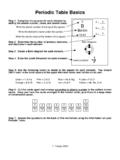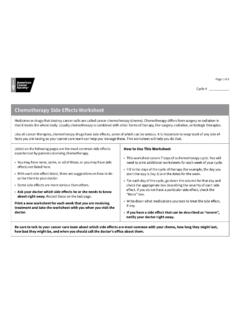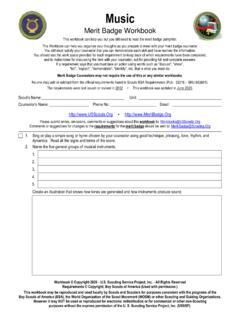Transcription of Chemical Reactions Name - sciencespot.net
1 Chemical Reactions Name _____. 1. Watch the video and then complete the chart. Type of Reaction Definition Equation ____ + ____ ____. Synthesis ____ ____ + ____. Decomposition ____ + ____ ____ + ____. Single Replacement Double ____ + ____ ____ + ____. Replacement Colors: A = Red, B = Blue, C = Green, D = Yellow 2. Use colored pencils to circle the common atoms or compounds in each equation to help you determine the type of reaction it illustrates. Use the code below to classify each reaction. S = Synthesis D = Decomposition SR = Single Replacement DR = Double Replacement _____ P + O2 P4O10 _____ Mg + O2 MgO. _____ HgO Hg + O2 _____ Al2O3 Al + O2. _____ Cl2 + NaBr NaCl + Br2 _____ H2 + N2 NH3. _____ Na + Br2 NaBr _____ CuCl2 + H2S CuS + HCl _____ HgO + Cl2 HgCl + O2 _____ C + H2 CH4. _____ KClO3 KCl + O2 _____ S8 + F2 SF6. _____ BaCl2 + Na2 SO4 NaCl + BaSO4.
2 T. Trimpe 2010 Chemical Reactions ANSWER KEY. 1. Watch the video and then complete the chart. Teacher notes on next page! Colors: A = Red, B = Blue, C = Green, D = Yellow 2. Use colored pencils to circle the common atoms or compounds on each side of the equations to help you determine the type of reaction it illustrates. Use the code below to classify each reaction. S = Synthesis D = Decomposition SR = Single Replacement DR = Double Replacement S S. _____ P + O2 P4O10 _____ Mg + O2 MgO. D D. _____ HgO Hg + O2 _____ Al2O3 Al + O2. SR S. _____ Cl2 + NaBr NaCl + Br2 _____ H2 + N2 NH3. R. S DR. _____ Na + Br2 NaBr _____ CuCl2 + H2S CuS + HCl SR HgO + Cl2 HgCl + O2 S C + H2 CH4. _____ _____. D KClO3 KCl + O2 S S8 + F2 SF6. _____ _____. DR BaCl2 + Na2 SO4 NaCl + BaSO4 Note: SO4 is a polyatomic ion. _____. T. Trimpe 2010 Teacher Notes: My students have difficulty identify the different types of Chemical Reactions .
3 I use this worksheet after we have already discussed balancing equations to explore the differences between synthesis, decomposition, single replacement, and double replacement Reactions . A PowerPoint presentation is also available for use on a SmartBoard or other interactive whiteboard device. If you do not have access to this technology, you might consider printing the individual slides on transparencies and project them using a standard overhead projector. To start the lesson, the students watch a movie about Chemical Reactions . The "Physical Science Series: Chemical Reactions " movie is available on United Streaming if you have a subscription. A PowerPoint for this lesson is available at After the movie, I discuss each type of Chemical reaction and have the students complete the chart. We also add letters and colors in the third column to help them focus on what happens in each equation by comparing the reactants and products.
4 For #2, the students use colored pencils to circle the atoms on each side of the reaction. They use the same color for each atom to help them see what happens and then classify each using the code listed. NOTE: If they have not already completed the Balancing Equations worksheet on my website, you can have them balance each equation after they are done. T. Trimpe 2010















